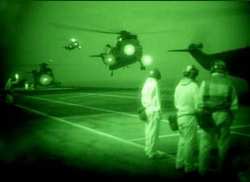Military Sats Can't Handle Bandwidth Demands, DOD Turns To
Private Sats
 In the war for Iraq, every aircraft, ship,
soldier, tank crewmember or ground-mobile infantry soldier is
linked by satellite to combat control rooms that could be dozens or
thousands of miles away.
In the war for Iraq, every aircraft, ship,
soldier, tank crewmember or ground-mobile infantry soldier is
linked by satellite to combat control rooms that could be dozens or
thousands of miles away.
The flood of data used to coordinate this fight is overwhelming,
compared to the amounts of raw data seen even just a year ago in
Afghanistan. Herein, lies the rub: the raw data stream by far
outstrips the relay capacity of Department of Defense
satellites.
To meet its growing need for bandwidth, the Pentagon has snapped
up the services of several commercial satellite companies. Still,
battlefield commanders are not satisfied.
"When you are in combat, you want more of everything: You want
more bullets, you want more beans, you want more bits," said Tim
Bonds, an analyst at the Rand Corp. in Santa Monica (CA).
Bandwidth: Expensive Addiction
 More bandwidth means the ability to put more
surveillance planes in the air to beam live video to the
dispatchers of bombs and missiles. It also means uncongested
conduits for encrypted conversation.
More bandwidth means the ability to put more
surveillance planes in the air to beam live video to the
dispatchers of bombs and missiles. It also means uncongested
conduits for encrypted conversation.
"We're very reliant on it," said Army Capt. John Morgan with the
22nd Mobile Public Affairs Attachment at Camp Doha in Kuwait. "What
the capacity does is allow us to respond much more quickly to the
situation on the ground, whether it's a downed aircraft or
assessing what effect our ground operations are having."
Pentagon Driving Up Costs for Private Users
From the first Gulf War a dozen years ago to today in Iraq, the
Pentagon's demand for bandwidth has increased roughly tenfold, USAF
Space Command spokesman Michael Kucharek said.
The military's own satellites carry a smaller and smaller
percentage of its communications traffic. Commercial providers
ferry the bulk.
During the 1991 conflict, Pentagon and NATO satellites carried
an estimated 85 percent of military communications. Not even a
decade later, during the Kosovo crisis, the percentages
flip-flopped, said Bonds.
Pentagon More Comfy With Commercial Sat Providers
The situation owes in part to the Pentagon's increased "comfort"
in relying on commercial providers to carry encrypted military
data, Bonds said. Among them are PanAmSat Corp., Intelsat Ltd. and
Inmarsat Ltd. And Paris-based Eutelsat SA recently won a Pentagon
contract. As the additional huge bidder (the DoD) enters the market
for private satellite services, the effect that can be expected is
a rise in prices, as satellite companies will be forced to either
add capacity, or to ration bandwidth to civilian customers.
 One big source of bandwidth thirst is the growing
reliance on videoconferencing to keep distant war planners in close
contact with front-line leaders.
One big source of bandwidth thirst is the growing
reliance on videoconferencing to keep distant war planners in close
contact with front-line leaders.
Video beamed from Predator and Global Hawk drones is also
bandwidth-intensive. "It starts to eat up a lot of bandwidth when
you talk imagery," Kucharek said. Some of the military's
jam-resistant satellites relay data at a pokey 2.6 kilobits per
second, or less than 5 percent the speed of a 56 kbps dial-up
connection to the Internet.
"That's fine for voice, but try pushing video through that,"
Kucharek added.
For the military, the increased use of commercial satellites
comes at a time when the market has significant excess
capacity.
In recent years, the industry had scrambled to beef up its
satellite fleet to accommodate projected growth in commercial need
for bandwidth. That need largely failed to materialize after the
dot-com crash, analysts said.
The Biggest Customer On Earth
The military has since taken up much of the slack: Since the
Sept. 11, 2001, terrorist attacks, the U.S. government has become
the largest customer in the commercial satellite market, said Tom
Eaton, executive vice president of sales and marketing for Wilton
(CN)-based PanAmSat.
The Department of Defense was not able to break out how much it
spends on commercial satellite services, Pentagon spokesman Lt.
Col. Gary Keck said.
 The Defense Department's use of commercial
satellites, even as it launches more "birds" of its own, will
likely continue: Projections call for a five- or six-fold jump in
military communications by 2010, Bonds said.
The Defense Department's use of commercial
satellites, even as it launches more "birds" of its own, will
likely continue: Projections call for a five- or six-fold jump in
military communications by 2010, Bonds said.
Help will also come from advanced technologies, including laser
communications and new Internet protocols, which could increase the
military's bandwidth anywhere from 10 to 100 times current
capacity, Air Force Undersecretary Peter Teets recently told a
House subcommittee.
But for now, the Pentagon is much like that PC user who craves a
faster Internet connection to speed surfing and downloads.
During the war, the military by necessity must prioritize the
communications it relays by satellite, Kucharek said.
But At What Cost?
What suffers? U.S. commanders refused to discuss that. "We don't
want to tell the world what our capabilities and limitations are,
because that would help the enemy," the Army's Morgan said.
 Airborne-Flight Training 05.09.24: ERAU at AIAA, LIFT Diamond Buy, Epic A&P
Airborne-Flight Training 05.09.24: ERAU at AIAA, LIFT Diamond Buy, Epic A&P ANN's Daily Aero-Term (05.07.24): Hazardous Weather Information
ANN's Daily Aero-Term (05.07.24): Hazardous Weather Information Aero-News: Quote of the Day (05.07.24)
Aero-News: Quote of the Day (05.07.24) NTSB Final Report: Cessna 150
NTSB Final Report: Cessna 150 Aero-News: Quote of the Day (05.08.24)
Aero-News: Quote of the Day (05.08.24)






